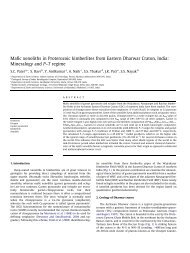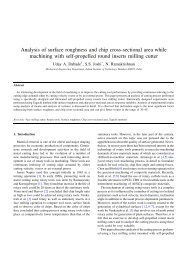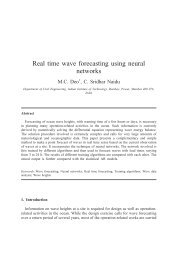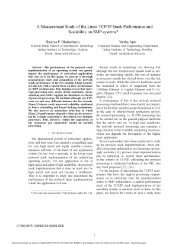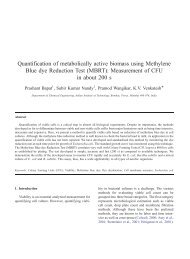Infrared signature studies of aerospace vehicles - DSpace at IIT ...
Infrared signature studies of aerospace vehicles - DSpace at IIT ...
Infrared signature studies of aerospace vehicles - DSpace at IIT ...
Create successful ePaper yourself
Turn your PDF publications into a flip-book with our unique Google optimized e-Paper software.
adi<strong>at</strong>ion from an engine exhaust plume, based on<br />
the combin<strong>at</strong>ion <strong>of</strong> radi<strong>at</strong>ion from the surface and<br />
the gaseous plume. The modelling determines the<br />
complic<strong>at</strong>ed geometry <strong>of</strong> the radi<strong>at</strong>ing volume<br />
consisting <strong>of</strong> jet and nozzle surfaces. The model<br />
predicts important peaks (which are experimentally<br />
valid<strong>at</strong>ed) <strong>at</strong> 2.7 and 4.3 mm, corresponding to<br />
emission from CO2. A peak <strong>at</strong> 5.8 mm is also<br />
predicted th<strong>at</strong> corresponds to nozzle surface radi<strong>at</strong>ion<br />
<strong>at</strong> its temper<strong>at</strong>ure [61]. The Standardized<br />
<strong>Infrared</strong> Radi<strong>at</strong>ion Model (SIRRM) code developed<br />
under JANNAF (Joint Army Navy NASA<br />
Air Force) project, predicts IR radi<strong>at</strong>ion from<br />
missile and aircraft plumes [72]. The code also<br />
predicts the effect <strong>of</strong> carbon particles on IR<br />
emission characteristics <strong>of</strong> plume. Bakker et al.<br />
[73] gave a brief methodology for computing plume<br />
IR <strong>sign<strong>at</strong>ure</strong>s from naval ship gas turbine engines,<br />
using NATO’s NPLUME program for exhaust field<br />
comput<strong>at</strong>ions.<br />
Hypothetical band models for plume IR-radi<strong>at</strong>ion<br />
modelling are classified into narrow-band and<br />
wide-band models. Wide-band models are used for<br />
obtaining total quantities, while narrow-band models<br />
are used for spectral inform<strong>at</strong>ion [61]. Ibgui and<br />
Hartmann [74] and Ibgui et al. [75] developed an<br />
optimized line-by-line FORTRAN code for the<br />
calcul<strong>at</strong>ion <strong>of</strong> aircraft plume IR <strong>sign<strong>at</strong>ure</strong>. The<br />
results obtained by the model were in good agreement<br />
with the measured labor<strong>at</strong>ory simul<strong>at</strong>ion<br />
results. Soufiani and Taine [76] obtained the emis-<br />
.sivity <strong>of</strong> gases resulting from hydrocarbon combustion<br />
by using a st<strong>at</strong>istical narrow-band model,<br />
which provides fast results <strong>at</strong> reasonable accuracy<br />
[77]. The effect <strong>of</strong> Line Doppler Shift (LDS) is<br />
important when there is a rel<strong>at</strong>ive velocity between<br />
radi<strong>at</strong>ing gas layers, e.g. aircraft plume [77].<br />
Consider<strong>at</strong>ion <strong>of</strong> LDS-effect on plume IR predictions<br />
using narrow-band model shows apparent<br />
increase in radiance compared to calcul<strong>at</strong>ions by<br />
line-by-line techniques [77].<br />
Comput<strong>at</strong>ional Fluid Dynamics (CFD) simul<strong>at</strong>ion<br />
<strong>of</strong> aircraft plumes for obtaining temper<strong>at</strong>ure,<br />
pressure, and concentr<strong>at</strong>ion distributions is also<br />
reported [78]. It is inferred th<strong>at</strong> the spectral intensity<br />
<strong>of</strong> aircraft plumes as received by IR-guided SAMs<br />
in non-afterburning mode, is prominent only in the<br />
4.14–4.45 mm band (Fig. 12) [79]. In non-afterburning<br />
mode, the IRSL from the plume is much<br />
lower than from the tail-pipe and rear fuselage,<br />
which is contrary to popular belief. Further, there is<br />
no emission from gaseous plumes in the 8–12 mm<br />
ARTICLE IN PRESS<br />
Radiance Intensity (W m -2 ⋅Sr -1 ⋅μm -1 )<br />
160<br />
120<br />
80<br />
40<br />
0<br />
0 4 8 12 16 20<br />
λ (μm)<br />
Fig. 12. Spectral radiance intensity <strong>of</strong> aircraft plume (after [79]).<br />
band (even in afterburning mode); but solid surfaces<br />
being grey, emit <strong>at</strong> all wavelengths <strong>at</strong> all temper<strong>at</strong>ures.<br />
Plume IR <strong>sign<strong>at</strong>ure</strong>s were measured experimentally<br />
by Cogliandro and Castelli [80], using<br />
Rolls-Royce GEM.2-MK.1000 engine delivering<br />
750 hp. Comparison <strong>of</strong> experimental results with<br />
theoretical results showed th<strong>at</strong> the experimental<br />
results in 1–14.5 mm band are accur<strong>at</strong>e within 10%.<br />
The IR emission from rocket plumes is <strong>of</strong> interest<br />
for its role in base he<strong>at</strong>ing and engine performance<br />
diagnostics. It is also <strong>of</strong> importance in str<strong>at</strong>egic<br />
functions like early warning, surveillance, acquisition,<br />
and tracking [81,82]. Parameters affecting<br />
plume IR <strong>sign<strong>at</strong>ure</strong> can be grouped into four<br />
c<strong>at</strong>egories, viz. engine, vehicle, flight, and ambient.<br />
The engine parameters are mass flow r<strong>at</strong>e, propellant<br />
type, mixture r<strong>at</strong>io (r<strong>at</strong>io <strong>of</strong> oxidizer mass to<br />
fuel mass), chamber pressure, area r<strong>at</strong>io, and nozzle<br />
contour. Vehicle parameters include number <strong>of</strong><br />
nozzles, nozzle spacing, cant angle, and base<br />
diameter. Altitude, velocity, and angle <strong>of</strong> <strong>at</strong>tack<br />
are flight parameters; and solar azimuth/elev<strong>at</strong>ion<br />
and earthshine/sunshine/skyshine are ambient parameters<br />
[81]. A rocket plume radi<strong>at</strong>es strongly near<br />
4.3 mm, because <strong>of</strong> the CO2 band; but burning <strong>of</strong><br />
combustible species is most striking in missiles flying<br />
below 30 km [83]. Due to this continuing combustion<br />
reaction after the nozzle exit, the plume<br />
temper<strong>at</strong>ure and IR <strong>sign<strong>at</strong>ure</strong> are raised [84–86].<br />
The IR emission from rocket plume is sensitive to<br />
concentr<strong>at</strong>ion <strong>of</strong> carbon particles in the plume. For<br />
the same concentr<strong>at</strong>ion <strong>of</strong> carbon particles, vari<strong>at</strong>ion<br />
in their size has no effect on IR emissions from<br />
the plume [84]. High altitude plume radi<strong>at</strong>es more<br />
IR <strong>sign<strong>at</strong>ure</strong> than <strong>at</strong> sea level; because for same<br />
nozzle exit conditions, high altitude plumes are<br />
bigger than the plume <strong>at</strong> sea level [87].<br />
231



